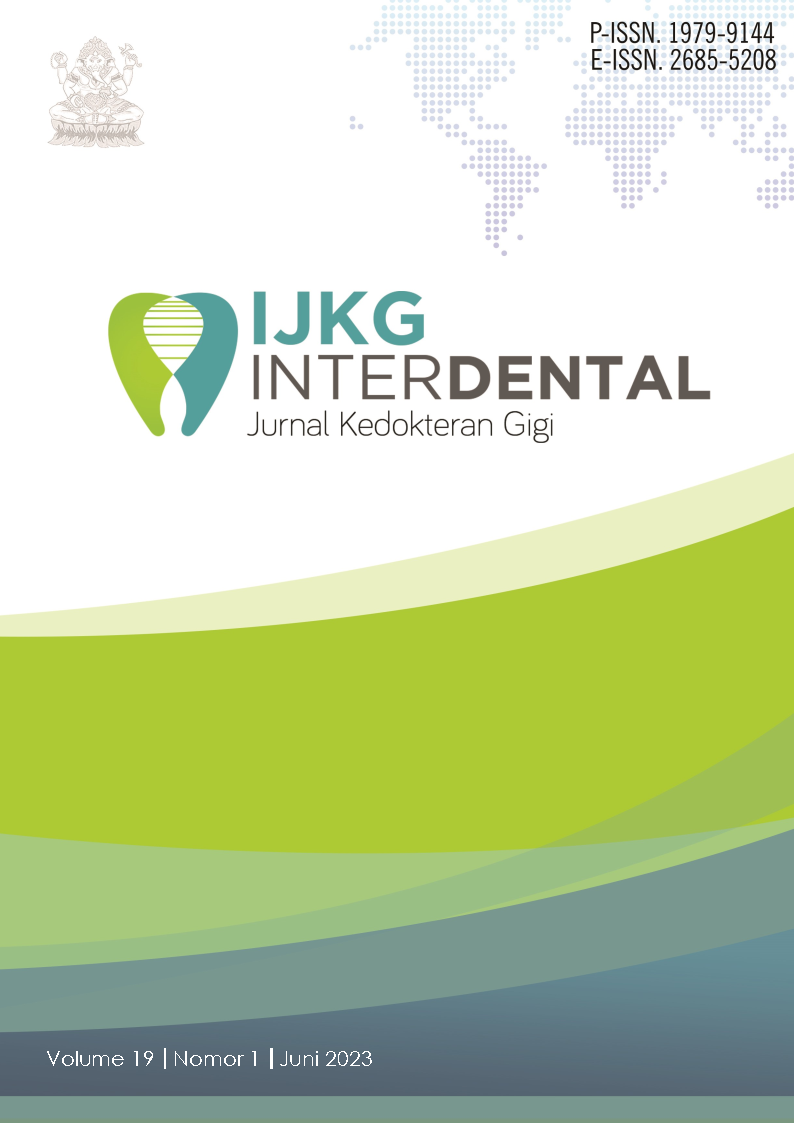EFFECTIVENESS OF RED BITES FRUIT (Beta vulgaris) AS A MOUTH MOUTH TO REDUCE HALITOSIS
EFEKTIFITAS SARI PERASAN BUAH BIT MERAH (Beta Vulgaris) SEBAGAI OBAT KUMUR TERHADAP PENURUNAN TINGKAT HALITOSIS
DOI:
https://doi.org/10.46862/interdental.v19i1.6094Keywords:
Bad breath, BeetrootAbstract
Introduction: Halitosis or bad breath is often a problem because it can reduce the fluency of communication which causes embarrassment in socializing so that it has a psychological impact which results in low self-esteem, loss of self-image and can cause stress. This writing aims to determine the role of beets on the level of halitosis reduction. Review: Most of the known causes of halitosis come from food scrap left in the oral cavity which is processed by the normal flora of the oral cavity, and are the result of the production of the activity of bacteria in the mouth that causes the formation of Volatile Sulfur Compounds (VSC) in the oral cavity, which is a sulfur compound that is volatile and smells bad. Since time immemorial, many people believe that natural ingredients are able to treat various diseases because they are considered less likely to cause side effects compared to synthetic drugs. One of the natural ingredients that can be used is beetroot. Beetroot contains several active compounds such as carotenoids, saponins, glycine betanin, betanin, polyphenols, flavonoids, phenols, tannins and alkaloids. Beetroot is thought to be able to reduce the level of halitosis because the compounds in beets contain antibacterial active substances that can reduce bacteria in the oral cavity in reducing the level of halitosis. Conclusion: Beets (Beta Vulgaris) are effective in reducing the level of halitosis because they have antibacterial properties.
Downloads
References
Mahesarani T. Obat Kumur Murah dan Baik. Jakarta: EGC, 2010: 10.
Asnul H, Abral. Efektifitas obat kumur dalam menghilangkan bau mulut (halitosis) pada perokok aktif. Jurnal Keperawatan Gigi. 2004; 10(2):134-136.
Regezi JA, Sciubba J, Jordan RC.: Oral Pathology: Clinical Pathologic Correlations, 7th edition. St. Louis: Elsevier/Saunders, 2017.
Diyah APY, Blambangan BGPB, Dewi JC, Herdianto RS, Mumtaza I, Nafiis MM, Novesia, Rosyidah I, Susanti TNE, Syarofi NMR. Pengetahuan penanganan halitosis dalam masalah kesehatan mulut. Jurnal Farmasi Komunitas. 2016; 3(2): 85-89.
Wijayanti YR. Metode mengatasi bau mulut. Cakradonya Dental Journal 2014, 6(1): 629-634.
Dias MG, Camões MFGFC, Oliveira L. Carotenoids in traditional Portuguese fruits and vegetables. Food Chemistry. 2009; 113(3): 808-815.
Atamanova SA, Brezhneva TA, Slivkin AI, Nikolaevskii VA, Selemenev VF, Mironenko NV. Isolation of saponins from table beetroot and primary evaluation of their pharmacological activity. Pharmaceutical Chemistry Journal. 2005; 39(12): 650-652.
De Zwart FJ, Slow S, Payne RJ, Lever M, George PM, Gerrard JA, Chambers ST. Glycine betaine and glycine betaine analogues in common foods. Food Chemistry. 2003; 83(2):197-204.
Váli L, Stefanovits-Bányai É, Szentmihályi K, Fébel H, Sárdi É, Lugasi A, Kocsis I, Blázovics A. Liver - Protecting effects off table beet (Beta vulgaris var. rubra) during ischemia-reperfusion. Nutrition. 2007; 23(2): 172-178.
El-Beltagi HS, Mohamed HI, Megahed BMH, Gamal M, Safwat G. Evaluation of some chemical constituents, antioxidant, antibacterial and anticancer activities of beta Vulgaris L. Root. Fresenius Environmental Bulletin. 2018; 27(9): 6369-6378.
Gupta VP.: Differential Diagnosis of Dental Diseases. New Delhi: Jaypee Brothers Medical Publishers (P) Ltd; 2008. p. 410-412.
Kvist T, Annerbäck EM, Dahllöf G. Oral health in children investigated by Social services on suspicion of child abuse and neglect. Child Abuse & Neglect. 2018; 76: 515-523.
Sterer N, Rosenberg M. Breath Odors: Origin, Diagnosis, and Management. Cham: Springer Nature; 2020. p. 59-70.
Davies AN, Epstein JB. Oral Complications of Cancer and Its Management. Oxford: Oxford University Press; 2010. p. 233-238.
Ongole R, Shenoy N. Halitosis: Much beyond oral malodour. Kathmandu University Medical Journal. 2010; 8(2): 269-275.
Pintauli S, Hamada T. Menuju Gigi dan Mulut Sehat Pencegahan dan Pemeriksaan. Medan: USU Press; 2012. p. 49-61.
Rana MK. Vegetable Crop Science. Boca Raton: CRC Press; 2017. p. 247-260.
Nayik GA, Gull A. Antioxidants in Vegetables and Nuts-Properties and Health Benefits. Singapore: Springer; 2020. p. 45-74.
Lestari PP. Study Pembuatan Jelly Umbi Bit (Beta vulgaris L) dengan Penambahan Kayu Manis (Cinnamomum burmani). Thesis. Mojokerto: Fakultas Teknik Program Studi Teknologi Hasil Pertanian Universitas Islam Majapahit; 2020. p. 30- 31.
Clifford T, Howatson G, West DJ, Stevenson EJ. The potential benefits of red beetroot supplementation in health and disease. Nutrients. 2015; 7(4): 2801-2822.
Amalia A, Sari I, Nursanty R. Aktivitas antibakteri ekstrak etil asetat daun sembung (Blumea balsamifera (L.) DC.) terhadap pertumbuhan bakteri Methicillin Resistant Staphylococcus aureus (MRSA). Prosiding Seminar Nasional Biotik; 2017; Aceh, Fakultas Tarbiyah dan Keguruan Universitas Islam Negeri Ar-Raniry; 5(1): 387-391.
Steenis V. Buah Bit (Beta Vulgaris L). Jakarta: PT Gramedia Pustaka; 2005. p. 45-49.
Lestari IK, Nazip K, Estuningsih S. Test of effectiveness of antibacterial of ethanol extract of Loranthus of tea (Scurulla atropurpurea BL Danser) on the growth of Enterobacter sakazakii. International Conference on Food, Biological and Medical Sciences (FBMS). 2014; 2014: 28-29.
Rijayanti RP. Uji aktivitas antibakteri ekstrak etanol daun mangga bacang (Mangifera Foetida L.) terhadap Staphylococcus aureus secara in vitro. Jurnal Mahasiswa PSPD FK Universitas Tanjungpura. 2014; 1(1): 9-14.
Grant MM, Jönsson D. Next generation sequencing discoveries of the nitrate-responsive oral microbiome and its effect on vascular responses. Journal of Clinical Medicine. 2019; 8(8): 1110.
Sistyaningrum T.: Efektivitas Kumur Sari Umbi Bit Merah (Beta vulgaris L.) terhadap Jumlah Streptococcus sp. dalam Plak Gigi. Jember: Fakultas Kedokteran Gigi Universitas Jember; 2017. p. 29-35.
Downloads
Published
How to Cite
Issue
Section
License
- Every manuscript submitted to must observe the policy and terms set by the Interdental Jurnal Kedokteran Gigi (IJKG)
- Publication rights to manuscript content published by the Interdental Jurnal Kedokteran Gigi (IJKG) is owned by the journal with the consent and approval of the author(s) concerned.
- Full texts of electronically published manuscripts can be accessed free of charge and used according to the license shown below.













